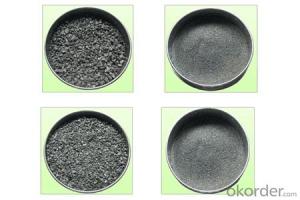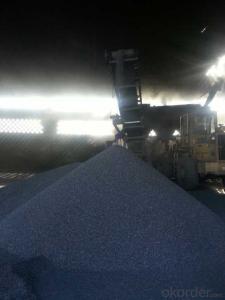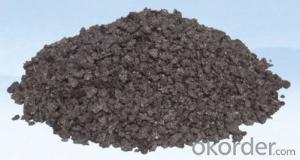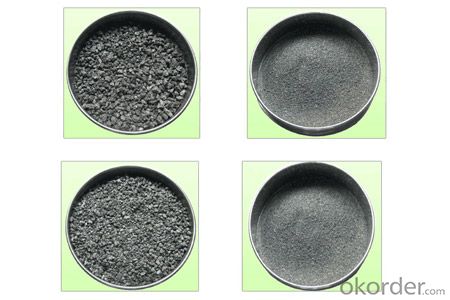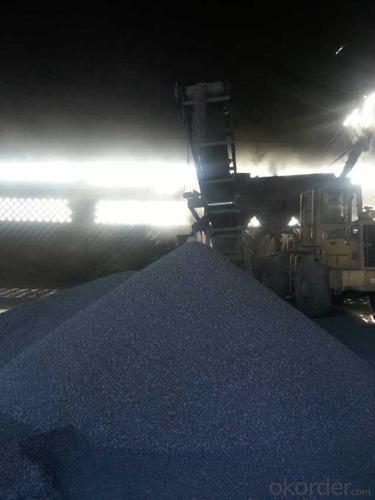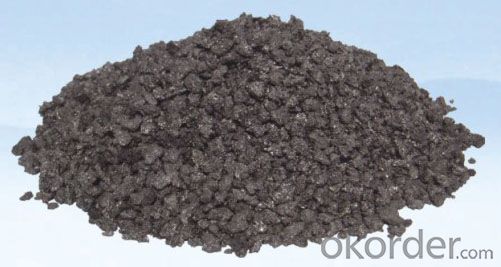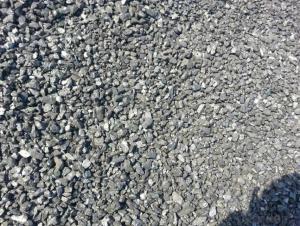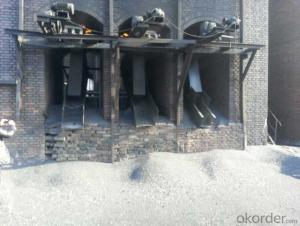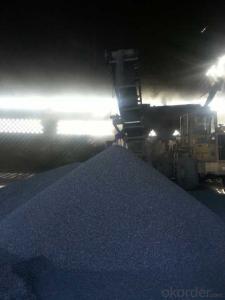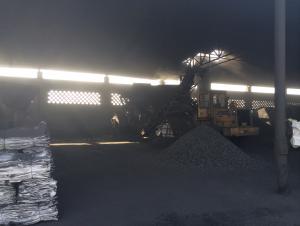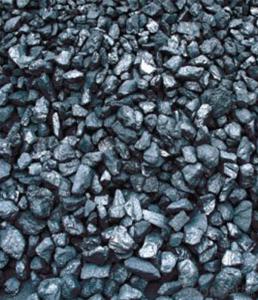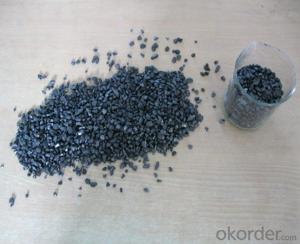Carbon Additive FC 90%-95% CNBM China Supplier
- Loading Port:
- Tianjin
- Payment Terms:
- TT OR LC
- Min Order Qty:
- 0 m.t.
- Supply Capability:
- 100000 m.t./month
OKorder Service Pledge
OKorder Financial Service
You Might Also Like
Packaging & Delivery
Packaging Detail: | 25kgs/50kgs/1ton per bag or as buyer's request |
Delivery Detail: | Within 20 days after receiving corect L/C |
Application
The Calcined Anthracite Coal/Gas Calcined Anthracite Coal/Carbon Raiser is mainly used in steelmaking in electrical stove, screening water, shipbuilding sandblast to remove rust. It can reduce the cost of steelmaking effectively by replacing the traditional petroleum coke of carburant.Also can improve the Carbon content in steel-melting and Ductile iron foundry.
Feature
All of our goods are made in the best quality of world famous Tianjin. All of our products are with High carbon, Low ash, low sulphur, Low Moisture.
Specifications
Calcined Anthracite
Fixed carbon: 90%-95%
S: 0.5% max
Size: 0-3. 3-5.3-15 or as request
PARAMETER UNIT GUARANTEE VALUE | |||||
F.C.% | 95MIN | 94MIN | 93MIN | 92MIN | 90MIN |
ASH % | 4MAX | 5MAX | 6MAX | 7MAX | 8MAX |
V.M.% | 1 MAX | 1MAX | 1.5MAX | 1.5MAX | 1.5MAX |
SULFUR % | 0.5MAX | 0.5MAX | 0.5MAX | 0.5MAX | 0.5MAX |
MOISTURE % | 0.5MAX | 0.5MAX | 0.5MAX | 0.5MAX | 0.5MAX |
Size can be adjusted based on buyer's request.
Picture

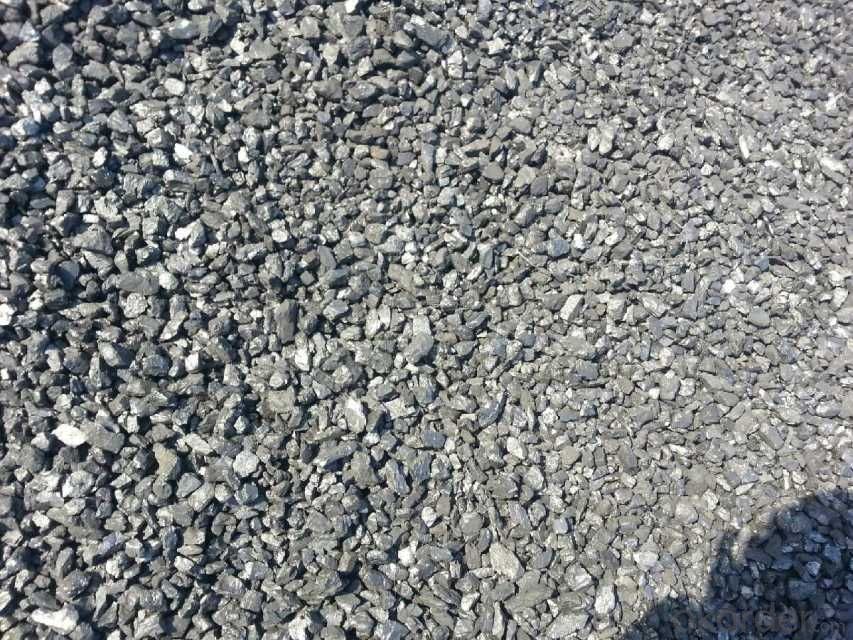
- Q: How does carbon affect the formation of acidification in lakes?
- Carbon dioxide (CO2) dissolved in water forms carbonic acid (H2CO3), which lowers the pH level of the water. This acidic environment can lead to acidification in lakes and other bodies of water.
- Q: How is carbon used in the production of pharmaceuticals?
- Carbon is used in the production of pharmaceuticals through various processes such as carbonization, activation, and purification. It serves as a crucial component in the synthesis of drugs and plays a significant role in drug formulation, purification, and separation processes. Additionally, carbon-based materials are utilized as drug carriers and adsorbents to enhance drug delivery and optimize the efficiency of pharmaceutical manufacturing.
- Q: How are carbon nanomaterials used in electronics?
- Due to their unique properties and versatility, carbon nanomaterials find widespread use in the field of electronics. A common application of these materials is in the creation of highly efficient and flexible conductive materials. Both carbon nanotubes (CNTs) and graphene, which fall under the category of carbon nanomaterials, possess remarkable electrical conductivity, making them ideal for the production of conductive components in electronic devices. CNTs are cylindrical structures comprised of rolled-up graphene sheets. They can be utilized as interconnects in integrated circuits, enhancing performance by reducing resistance and promoting heat dissipation. Furthermore, CNTs can be employed in transistors, facilitating faster and more efficient switching due to their high electron mobility. Their small size and flexibility render them suitable for the construction of transparent conductive films used in touchscreens and flexible electronics. On the other hand, graphene is a two-dimensional sheet composed of carbon atoms arranged in a hexagonal lattice. It is renowned for its exceptional electrical conductivity, high electron mobility, and excellent thermal conductivity. Materials based on graphene can function as electrodes in batteries and supercapacitors, thereby enhancing their energy storage capacity. Additionally, graphene transistors possess the potential to replace traditional silicon-based transistors, resulting in faster and more energy-efficient electronic devices. Furthermore, carbon nanomaterials, particularly CNTs, exhibit promise in the realm of nanoelectromechanical systems (NEMS). NEMS devices are exceedingly small and sensitive, enabling applications such as sensors, actuators, and resonators. CNT-based NEMS devices have displayed exceptional sensitivity and responsiveness, making them suitable for various sensing applications, including pressure, gas, and biological sensing. In conclusion, carbon nanomaterials play a vital role in the field of electronics by offering highly conductive and versatile materials for different components and applications. Their unique properties, such as excellent electrical and thermal conductivity, make them ideal for the production of faster, more efficient, and flexible electronic devices. As research and development in this field continue to advance, carbon nanomaterials are poised to revolutionize the electronics industry.
- Q: What are the consequences of increased carbon emissions on forest ecosystems?
- Increased carbon emissions have a range of negative consequences on forest ecosystems. Firstly, higher levels of carbon dioxide in the atmosphere contribute to global warming, leading to higher temperatures and altered precipitation patterns, which can negatively impact the growth and health of forest plants. Additionally, increased carbon dioxide levels can stimulate the growth of invasive plant species, leading to competition and reduced biodiversity. Moreover, carbon emissions contribute to ocean acidification, which can harm marine ecosystems that are interconnected with forests. Lastly, increased carbon emissions can intensify the frequency and severity of wildfires, posing a significant threat to forest ecosystems and their ability to regenerate.
- Q: How does carbon impact the prevalence of droughts?
- Droughts are significantly influenced by carbon, specifically in the form of carbon dioxide (CO2) emissions. The prevalence of droughts is attributed to the increased levels of carbon in the atmosphere, which contribute to global warming and impact climate patterns globally. Human activities, such as the burning of fossil fuels and deforestation, release carbon dioxide into the atmosphere. This carbon dioxide acts as a greenhouse gas, trapping heat from the sun and causing the Earth's temperature to rise. As the global temperature increases, precipitation patterns and evaporation rates undergo changes. Warmer temperatures accelerate evaporation, leading to more water evaporating from lakes, rivers, and soil. This increased evaporation, combined with altered precipitation patterns, results in drier conditions and reduced water availability in certain regions. Furthermore, the rising temperatures contribute to the intensification of the water cycle, leading to more extreme weather events. These events include more frequent and severe droughts, as well as intense rainfall in some areas, increasing the risk of floods. Moreover, carbon emissions also impact atmospheric circulation patterns, such as the weakening of the jet stream. The jet stream plays a crucial role in directing weather systems across the globe, including rain-bearing weather fronts. When it weakens, weather systems become stagnant, resulting in prolonged drought periods in certain regions. In summary, human activities that increase carbon levels in the atmosphere have a direct influence on global warming and climate change. These changes in climate patterns and atmospheric circulation, along with the intensification of the water cycle, significantly affect the occurrence and severity of droughts worldwide. Therefore, it is essential to reduce carbon emissions and address climate change in order to minimize the impacts of droughts on ecosystems, agriculture, and human populations.
- Q: What is the thickness of carbon fiber heating?
- A carbon fiber electric heating installation including adiabatic reflective material, galvanized iron, carbon fiber heating cable, cement layer, floor tile or wood flooring and other parts, generally about reflective thermal insulation material 2cm, galvanized iron net and carbon fiber heating cable 1cm, cement layer 2-3cm, tile or wood floors 2cm in general, add up to 7, 8cm. Insulation reflective material is insulation, galvanized iron mesh, cement layer is to protect cable, carbon fiber heating cable is the core component of carbon fiber heating system, play a role in heating.Two, the use of carbon fiber electric heating carbon fiber heating heating cable as the main part, according to the inherent characteristics of the carbon materials, and textile materials with porous and capricious, multi-faceted, the ends of pressure conductive, electric energy can be quickly converted into heat, by far infrared radiation heat to achieve the heating effect, this is the carbon fiber electric heating principle. Carbon fiber electric heating and electric heating are essentially different, the ordinary electric heating is dependent on the resistance wire heating, and the conduction mode of heat conduction, the disadvantage is the electric energy into heat energy conversion rate is low carbon fiber electric heating.
- Q: How does deforestation affect carbon levels?
- The atmosphere is significantly affected by deforestation, as it leads to higher carbon levels. Carbon dioxide (CO2) is absorbed by trees through photosynthesis and stored in their trunks, branches, leaves, and roots, playing a vital role in the carbon cycle. However, when forests are cleared or burned, the stored carbon is released back into the atmosphere as CO2, contributing to the greenhouse effect and climate change. Deforestation not only reduces the number of trees available to absorb CO2, but it also disrupts the natural balance of the carbon cycle. Forests function as carbon sinks, meaning they absorb more CO2 than they release, thus helping to regulate the Earth's climate. By cutting down forests, the carbon stored in their biomass is quickly released, worsening the issue of excess CO2 in the atmosphere. Moreover, deforestation affects the long-term carbon storage capacity of the planet. Young trees and newly regrown forests have lower carbon storage capabilities compared to older, mature forests. Consequently, clearing forests and replacing them with young vegetation or non-forested land significantly diminishes the ability to absorb and store carbon. The consequences of increased carbon levels in the atmosphere are extensive. Carbon dioxide acts as a greenhouse gas, trapping heat in the Earth's atmosphere and contributing to global warming and climate change. Rising temperatures result in a chain of effects, such as more frequent and intense extreme weather events, higher sea levels, and disruptions to ecosystems and biodiversity. To minimize the impact of deforestation on carbon levels, it is crucial to prioritize sustainable forest management practices and efforts for reforestation. Protecting existing forests and promoting afforestation and reforestation can help restore the planet's capacity to absorb carbon and contribute to global endeavors in combating climate change.
- Q: How does carbon affect the pH of water?
- Carbon does not directly affect the pH of water. However, when carbon dioxide dissolves in water, it forms carbonic acid, which lowers the pH of the water, making it slightly more acidic.
- Q: What are the applications of carbon nanowires?
- Carbon nanowires have a wide range of applications across various fields due to their unique properties and characteristics. Some of the key applications of carbon nanowires are: 1. Electronics: Carbon nanowires can be used as conducting channels in electronic devices, such as transistors and interconnects. Their high electrical conductivity, small size, and ability to carry high current densities make them ideal for use in nanoelectronics. 2. Energy storage: Carbon nanowires can be utilized in energy storage devices, such as batteries and supercapacitors. Their high surface area and excellent electrical conductivity enable efficient charge and energy storage, leading to enhanced performance and longer life cycles. 3. Sensors: Carbon nanowires can be used as sensing elements in various types of sensors. Their high sensitivity to changes in temperature, pressure, or gas concentration makes them suitable for applications in environmental monitoring, healthcare, and industrial sensing. 4. Biomedical applications: Carbon nanowires show promise in biomedical applications, including drug delivery systems and tissue engineering. They can be functionalized with specific molecules to target and deliver drugs to specific cells or tissues. Additionally, their high mechanical strength and biocompatibility make them suitable for scaffolds in tissue engineering applications. 5. Nanoelectromechanical systems (NEMS): Carbon nanowires can be used to construct NEMS devices, which are miniature mechanical systems that operate at the nanoscale. These devices have applications in sensing, actuation, and data storage, and carbon nanowires provide the necessary mechanical and electrical properties for their operation. 6. Nanocomposites: Carbon nanowires can be incorporated into various materials to enhance their mechanical, electrical, and thermal properties. They can reinforce polymers, ceramics, and metals, leading to improved strength, conductivity, and heat dissipation in the resulting nanocomposites. 7. Optoelectronics: Carbon nanowires can be utilized in optoelectronic devices, such as photodetectors and light-emitting diodes (LEDs). Their high electron mobility, low electrical resistance, and ability to emit light make them suitable for applications in displays, lighting, and optical communications. Overall, the applications of carbon nanowires are diverse and expanding, with the potential to revolutionize fields such as electronics, energy storage, sensing, biomedicine, and more. Continuous research and development in this area are expected to uncover even more exciting applications in the future.
- Q: How does carbon dioxide affect the formation of clouds?
- Carbon dioxide does not directly affect the formation of clouds. However, it is a greenhouse gas that contributes to global warming, leading to changes in atmospheric temperature and humidity, which can indirectly impact cloud formation and properties.
Send your message to us
Carbon Additive FC 90%-95% CNBM China Supplier
- Loading Port:
- Tianjin
- Payment Terms:
- TT OR LC
- Min Order Qty:
- 0 m.t.
- Supply Capability:
- 100000 m.t./month
OKorder Service Pledge
OKorder Financial Service
Similar products
Hot products
Hot Searches
